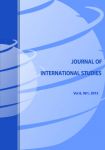ASYMMETRIC EFFECTS OF EXCHANGE RATE CHANGES ON THE DEMAND FOR DIVISIA MONEY IN MALAYSIA
ASYMMETRIC EFFECTS OF EXCHANGE RATE CHANGES ON THE DEMAND FOR DIVISIA MONEY IN MALAYSIA
Author(s): Choi-Meng Leong, Chin-Hong Puah, Evan Lau, Abu Mansor ShazaliSubject(s): Geography, Regional studies, Economic policy, Financial Markets
Published by: Fundacja Centrum Badań Socjologicznych
Keywords: financial liberalization; divisia monetary aggregate; exchange rate; asymmetric; money demand;
Summary/Abstract: Financial liberalisation has advanced the transformation of the financial market as more interest-bearing financial derivatives are introduced. Performance of the equal-weighted monetary aggregates has been affected and therefore disrupted the stability of money demand. Effectiveness of monetary policy is a concern as stability of money demand is required for a stable velocity derivation. Thus, the aim of this study is to derive a stable money demand function by considering the type of monetary aggregate included for estimation and the missing determinants of money demand. First, the divisia monetary aggregate is employed for money demand estimation in Malaysia. Second, the exchange rate is included as a determinant of money demand by employing the nonlinear autoregressive distributed lag approach to capture the asymmetric effects from exchange rate changes. The results indicate that all the variables are bound together in the long run and the model is stable. Asymmetric effects exist in the short run for both appreciation and depreciation. Long-run asymmetric effects only hold in currency appreciation in which a substitution effect exists between exchange rate and money demand. A stable money demand function contributes to formulation of monetary policy in Malaysia.
Journal: Journal of International Studies
- Issue Year: 12/2019
- Issue No: 4
- Page Range: 52-62
- Page Count: 11
- Language: English

